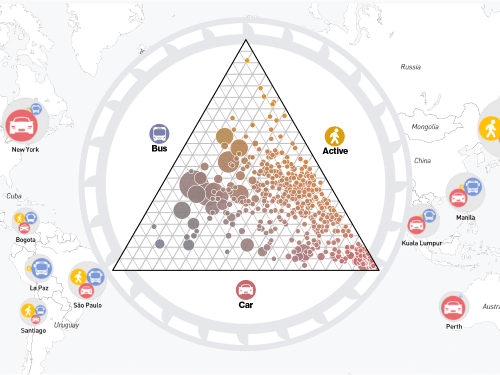Explore the interactive map and learn how people get around in 794 cities
What is the extent of car dependency around the world? Why should the best places to live be car-free? What are the best public transportation cities? A new study by Rafael Prieto-Curiel, from the Complexity Science Hub, and Juan Pablo Ospina, from EAFIT University, may provide some insights into these questions.
Prieto-Curiel and Ospina collected data on transportation modes across 794 cities in 61 countries, with a combined population of almost 850 million people. Their study describes how people commute in different parts of the world by modeling the use of modes of transportation in a city, such as cars, public transportation, and active mobility (walking and biking).
“The takeaway is clear: we drive too many cars, and the burden of cars in cities is huge and goes beyond the combustion of petrol. It is also the parking space required, the driving infrastructure, the noise they produce, the toxic materials used in manufacturing and road pavement, the crashes they cause, and others,” ponders Prieto-Curiel.
Globally, around 51% of commutes are made by car, according to the study published in Environment International. Across regions, the percentage varies greatly, with almost 92% of journeys being made by automobile in cities in the US and Canada. The percentage of commutes by car in Northern and Southern European cities ranges from 50% to 75%.
Check out the interactive visualizations – including a map of global mobility patterns – created by Liuhuaying Yang from the Complexity Science Hub, based on the data, and discover how your city compares to other locations around the world.
EUROPE: CAR-FREE AND CAR-FILLED CITIES
Yet the study also shows that people in Europe commute in vastly different ways. Some cities rely heavily on cars, like Rome, Italy (66%); and Manchester, England (71%). Additionally, a large number of commutes are made by bike or foot in different parts of the old continent: from Copenhagen, Denmark (47%); Utrecht, Netherlands (75%); to Bilbao, Spain (66%); and Bolzano, Italy (58%).
Furthermore, public transportation is crucial in some European cities. For instance, public transit accounts for the majority of journeys in Paris, France (60%). It also corresponds to 45% in London, England. Eastern European cities also tend to rely more on public transportation, like Minsk, Belarus (65%); Prague, Czech Republic (52%); Warsaw, Poland (47%); and Budapest, Hungary (45%).
ASIA: PUBLIC TRANSPORTATION, WALKING AND CYCLING
Similarly, public transportation accounts for a significant share of journeys in Southern and Eastern Asia, as shown in Hong Kong (77%); Seoul, South Korea (66%); Mumbai, India (52%); and Tokyo, Japan (51%). Additionally, Southern and Eastern Asia have the highest cycling share. In fact, there is a lot of walking and biking in big Asian cities, like Dhaka, Pakistan (58%); Beijing (53%) and Shanghai (47%), China; Tokyo, Japan (37%); and Mumbai (33%) and Delhi (33%), India.
LATIN AMERICA AND AFRICA
In cities in Latin America, commuting by car is not so frequent. Active mobility and public transport combine to a more balanced way of commuting. In Mexico City, for example, only 21% of the journeys are by car, but a vast metro system combined with other options, such as Bus Rapid Transit (BRT) and buses, take nearly half of the journeys in the city.
Commuting by car is also not common in African cities. However, in wealthier cities such as Cape Town, South Africa, car journeys are more frequent and, therefore, less sustainable. Prieto-Curiel argues that, except for the US, city size plays a significant role in determining transport patterns. According to the study, buses, metros, and trams are typically the most popular modes of transportation in large cities, as found in many European, Latin American, African, and Asian capitals.
US: CITIES DESIGNED FOR CARS
“In contrast, the US exhibits minimal variation in modal share across cities of different sizes,” point out Prieto-Curiel and Ospina. “The majority of cities in the US have been designed with a strong reliance on cars for transportation. While cities like New York City and Boulder have developed alternative mobility options, most cities in the US heavily depend on cars.”
As the study shows, in the United States and Canada, nearly 92% of commutes are made by car. Public transit makes up 4.6%, and active mobility makes up 3.5%.
Although cars have long dominated the road, the desire to reduce automobile use is growing in the US. Cities that are dense and walkable, such as San Francisco, Boston, and New York, have dependable public transit systems.
New York City is the most car-free city in the US, with the highest public transportation share (25%). Moreover, walking and biking account for 8% of commutes, the study shows. In both San Francisco and Boston, public transit accounts for 8% of journeys. Walking and cycling account for 6% of commutes in San Francisco and 7% in Boston.
American college towns are known for their love of walking and cycling, as evidenced in Ithaca (20%), State College (10%), Iowa City (10%), Boulder (9%), and Madison (8%).
HOW ABOUT ELECTRIC CARS?
The popularity of electric cars is soaring around the globe, with China, Europe, and the US leading the way. However, Prieto-Curiel and Ospina warn that electric vehicles are not the answer for cities. They emphasize that electric cars will continue to bear the burden associated with motorized mobility. “We must take into account manufacturing, infrastructure demands, congestion, particle pollution produced by tire wear, and others,” says Prieto-Curiel.
The authors of the study point out that active mobility and public transit present numerous physical, mental, and environmental benefits as alternatives to driving. However, they acknowledge that it is a difficult endeavor.
“Changing travel behavior is exceptionally challenging,” say Prieto-Curiel and Ospina. In addition, active mobility and public transportation have significant obstacles. Active mobility in medium and large cities is difficult due to long-distance commutes. In contrast, public transportation requires a sufficient amount of passengers to provide frequent service, so it is strongly influenced by the density of the population.
About the study
The study “ABC of mobility” by Rafael Prieto-Curiel and Juan Pablo Ospina was published in Environment International (doi: 10.1016/j.envint.2024.108541).
The dataset with all the cities is available here.







